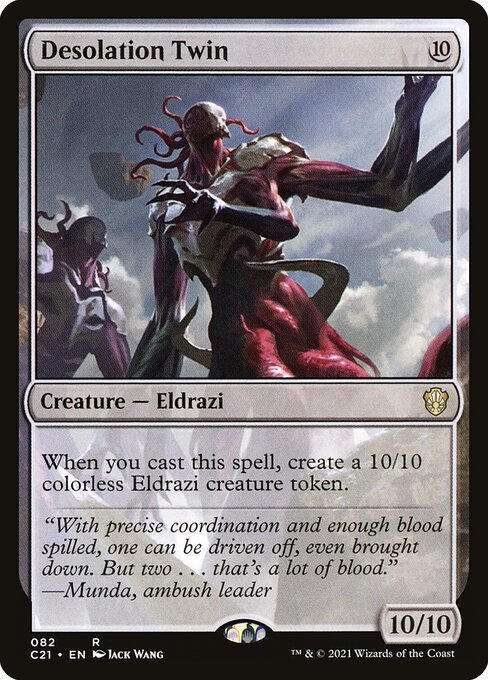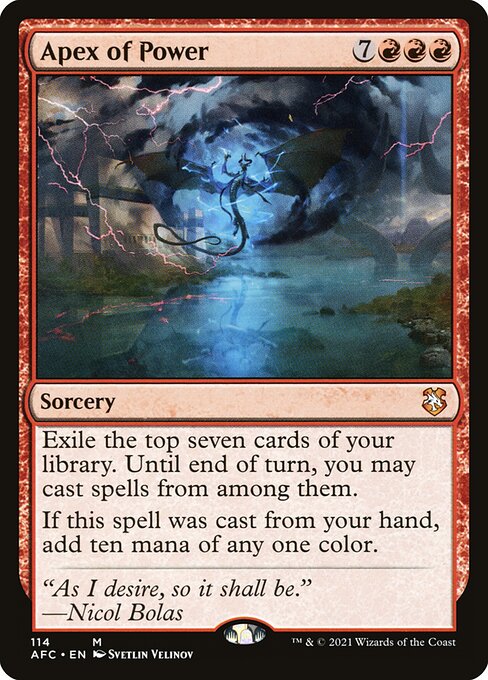I sought to write a first look guide to Double Masters Limited today based on all the commons and uncommons previewed. Unfortunately, only four commons have been previewed so far, and they all go together: Expedition Map, Urza’s Tower, Urza’s Mine, and Urza’s Power Plant. Having never drafted Master’s Edition IV, I can’t speak to the particulars of drafting common Tron lands, but they indicate likely themes of big mana and colorless cards in 2XM. Perhaps we’ll see Ulamog’s Crusher at common or a bunch of X spells. They’ll certainly fit into an artifact-heavy theme, which Mark Rosewater stated was the foundation for the set.
Rather than speculate about how an artifact-focused Masters set could be designed, since that may well be revealed by the time this article is out, let’s instead turn to the normally least Limited-relevant part of a booster: the rare slot.

Signpost Rares
Double Masters has two rare slots. The pool of possible rares and mythics are each more than double those of normal sets. In fact, there are so many rares that twenty of them are acting similarly to build-around uncommons. And you get two first picks every pack, so you never have to pass a rare.
All of this should drastically change the calculus of Limited. Draft decks tend to be sleeker than sealed decks, with better mana curves, more synergies between cards; they are defined by commons and uncommons. Sealed decks tend to be slower and bomb-heavier, since all players have guaranteed access to at least six rares. Double Masters looks like to combine these elements, leading to decks that combine the high power level ceiling of Sealed decks with the streamlined nature of draft decks.
In other words, Double Masters decks may well resemble Constructed or Cube decks. That isn’t unusual for a Masters set—all Masters sets boast higher than normal power levels. But double rares means that a larger percentage of games will be defined by game-ending rares. You’ll need to have a game plan for dealing with bomb rares, since you’ll possible see several every match. Fortunately, we have many examples of bomb-heavy formats to learn from.

Playing with Power
The first Limited format I learned was Scars of Mirrodin. It was defined by two things: Poison and bomb rares. There were so many bombs that ruined your day instantly. Sunblast Angel, Contagion Engine, and Carnifex Demon were nigh-unbeatable six mana plays (with Volition Reins a brutal uncommon as well). There were plenty of cards that your opponent could play to upend the game, but not enough good countermagic or discard to stop them (and removal after the fact often couldn’t undo the damage of their ETB effects). Basically, you hoped to open some of these or be able to go under them. Fate Reforged was similarly defined by many top tier rares and lackluster synergy (compared to that of Khans of Tarkir), so games were often decided by individually powerful cards. But the best recent example is undoubtedly War of the Spark.
War of the Spark was a controversial set, both for its swingy Limited format and the disruption it wrought upon all Constructed formats. It’s also one of my favorite formats—I adored how powerful the decks were. You needed to have a plan for all opposing planeswalkers, since you could win most games by simply protecting your own. It felt egalitarian that everyone’s decks packed a punch (though white and green’s uncommon planeswalkers were unfortunately underpowered). At any point, someone could slam Sarkhan, the Masterless, Nissa, Who Shakes the World, or even Ashiok, Dream Render and completely change the texture of the game.
All of this made two drops central to winning, especially two drops with evasion (Sky Theater Strix), built-in value (Burning Prophet, Lazotep Reaver), or disruption (Callous Dismissal, hands-down the best common in the set). The preponderance of planeswalkers at three and four mana also made creatures at those spots of the curve less attractive, since it was generally better to play a protected planeswalker than a random creature. This made expensive creatures less valuable, since your planeswalkers already packed a punch.

Trading Haymakers
Many of the lessons of War of the Spark should translate to Double Masters. You want to know general trends about bomb rares so you can be prepared. When do most of them hit the battlefield? Do they provide immediate effects, like Sunblast Angel and Vraska, Swarm’s Eminence, or will a removal spell be sufficient to cleanly answer them? What percentage of rares and mythics are overtly good, what percentage require an archetype to function, and how many of them just don’t work in Limited? If many of the rares are powerful and require little work to function, then most games will see several. If only a few are bonkers and a substantial portion are meant only for Constructed, then you’ll face fewer but have fewer yourself.
You want to understand how aspects of the format interact with the average bomb rare. Are there good enough aggressive decks that can reliably win before the average bomb turns the tide? How strong are the burn spells or anthem effects for pushing aggro deck across the finish line? How good are the defensive creatures, counterspells, and protection effects to help you survive until you find and cast your bombs? How many bombs need to be protected, and how can you best protect them?
War of the Spark was defined by attackable Planeswalkers, but if many bombs are noncreature artifacts or enchantments, one may need dedicated answers in the main deck. If many rares end the game, then cards like Divination tend to underperform, while cards like Impulse get better.
Waiting for more spoilers
There’s plenty to consider about a Limited format even with only a few tidbits of knowledge. Guessing at what Limited will be like is the most exciting part of spoiler season for me. Perhaps I’ve written a rough roadmap to success on release weekend, or perhaps I’ve completely missed the mark and it instead resembles Modern Masters 2013 (with rigid archetypes and many build-around rares) rather than War of the Spark.
Sadly, many of us won’t be spending release weekend with our friends at our local game stores. If you’re fortunate enough to live in a part of the world where you can safely and responsibly congregate at a draft table, I’m jealous of you and hope you have a blast. As a resident of the United States, my only Double Masters drafts for the foreseeable future will be digital, but I’m looking forward to booting up Magic Online and streaming a draft or three. Here’s looking forward to that.
And, as always, thanks for reading.
—Zachary Barash is a New York City-based game designer and the commissioner of Team Draft League. He designs for Kingdom Death: Monster, has a Game Design MFA from the NYU Game Center, and does freelance gatame design. When the stars align, he streams Magic (but the stars align way less often than he’d like).

